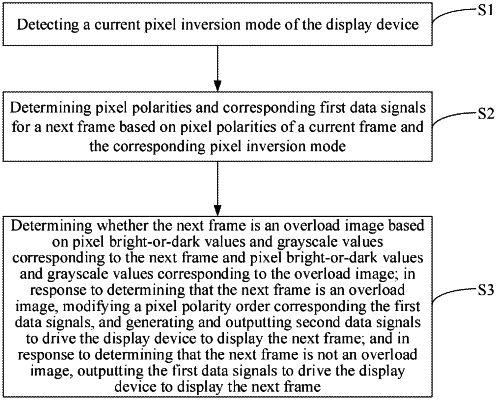| CPC G09G 3/3614 (2013.01) [G09G 3/3607 (2013.01); G09G 3/3688 (2013.01); G09G 2320/0271 (2013.01); G09G 2320/029 (2013.01); G09G 2330/021 (2013.01)] | 6 Claims |

|
1. A driving method of a display device, comprising:
detecting a current pixel inversion mode of the display device;
determining pixel polarities and corresponding first data signals for a next frame based on pixel polarities of a current frame and the pixel inversion mode; and
determining whether the next frame is an overload image based on pixel bright-or-dark values and grayscale values corresponding to the next frame and pixel bright-or-dark values and grayscale values corresponding to the overload image;
in response to determining that the next frame is an overload image, modifying a pixel polarity order corresponding the first data signals, and generating and outputting second data signals to drive the display device to display the next frame; and
in response to determining that the next frame is not an overload image, outputting the first data signals to drive the display device to display the next frame;
wherein the pixel polarities corresponding to the first data signals are in a different order from the pixel polarities corresponding to the second data signals; and wherein when the pixel polarity order corresponding to the first data signals corresponds to an overload image, an image corresponding to the second data signals is a non-overload image;
wherein the step of determining whether the next frame is an overload image based on pixel bright-or-dark values and grayscale values corresponding to the next frame and pixel bright-or-dark values and grayscale values of the overload image comprises:
determining whether the next frame is an overload image based on a minimum pixel unit of the next frame;
in response to determining that a number of minimum pixel units of the next frame each of which the pixel bright-or-dark values and grayscale values are identical with the pixel bright-or-dark values and grayscale values of a minimum pixel unit of the overload image is greater than a preset number, determining that the next frame is the overload image;
wherein when the inversion mode of the display device is dot inversion, the overload image is divided into a plurality of pixel sections where each pixel section comprise at least 2*4 pixels, and wherein a pixel driving architecture in each pixel section is as follows:
the grayscale values corresponding to the pixels in S4n+1 column are all bright; the grayscale values corresponding to the pixels in S4n+2 column are alternately bright, dark, bright, and dark; the grayscale values corresponding to the pixels in S4n+3 column are all dark; and the grayscale values corresponding to the pixels in S4n+4 column are alternately dark, bright, dark, and bright;
when the pixel is displayed as bright, the corresponding pixel bright-or-dark value is 111, and when a pixel is displayed as dark, the corresponding pixel bright-or-dark value is 000;
wherein the step of determining whether the next frame is an overload image based on the pixel bright-or-dark values and the grayscale values corresponding to the next frame and the pixel bright-or-dark values and the grayscale values of the overload image comprises:
in response to determining that the pixel bright-or-dark values and grayscale values of every four columns of pixels corresponding to the next frame are consistent with the pixel bright-or-dark values and grayscale values of every four columns of pixels of the overload image, determining that the next frame is the overload image.
|